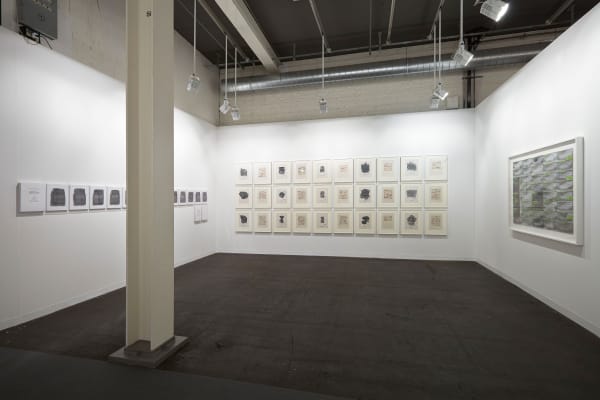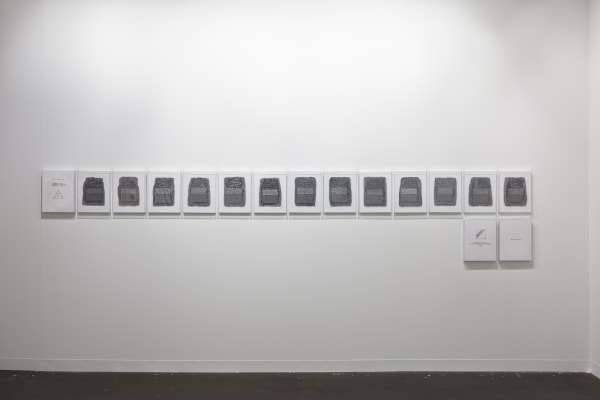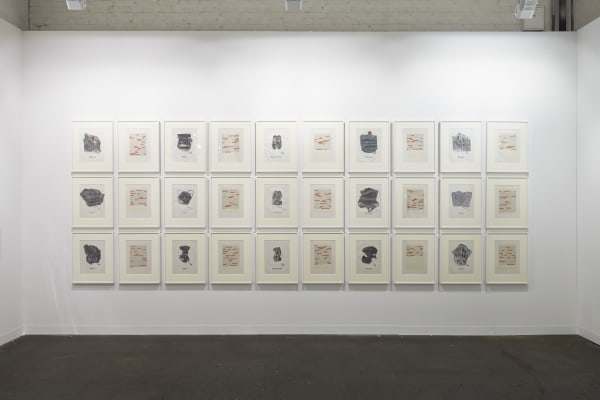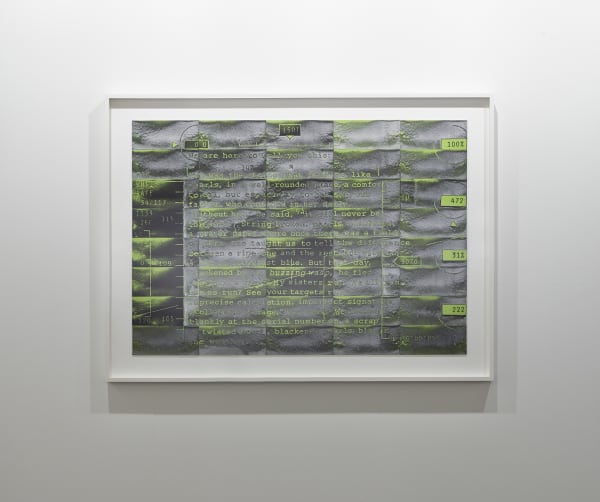Pippy Houldsworth Gallery is delighted to present a solo booth of Mary Kelly’s work at Art Basel 2014. Regarded as one of the most significant figures of feminist art, Kelly has had a profound influence on the development and critique of conceptual art. Using psychoanalytic methodology, Kelly’s project-based work has addressed questions of sexuality, identity and memory for more than four decades.
Her large-scale narrative installations, including Post-Partum Document (1973-79), Interim (1984-89), The Ballad of Kastriot Rexhepi (2001) and Love Songs (2005-07), have blurred the boundaries between the personal and the political by visualising the impact of historical events on the precarious nature of everyday life.
Documentation VI: Prewriting Alphabet, Exergue and Diary (1978), is the final section of Kelly’s iconic six-part work, Post-Partum Document (1973-79), first exhibited at the Institute for Contemporary Art, London, in 1976. Each of the six parts concentrates on a formative moment in the mother-child relationship in the first few years of life. Moving between the voices of mother, child and analytic observer, Documentation VI, of which she made two versions, captures the child’s emerging mastery of language with empirical precision, but at the same time, by casting the inscriptions in resin on slate, she imbues her procedure with the uncanny archeology of maternal loss. With all six parts of Post-Partum Document in international museum collections, (Moderna Museet, Tate Modern, Arts Council Collection, Art Gallery Ontario, Zurich Museum and the Australian National Gallery), the section on show at Basel, PPD VI (second version) is the only remaining section available of this seminal work.
Corpus, Preliminary Artwork (1984), comprises thirty collages that informed the production of the first part of Interim (1984-89), Kelly’s four-part installation that concerns the representation of feminine subjectivity and visual pleasure, taken up in relation to the specific themes of body, money, history and power. This is the first time that the preparatory drawings have been seen in their entirety since they were first exhibited at A Space, Toronto in 1986.
Each group of six panels in Corpus is named after one of the five passionate attitudes that psychiatrist Jean-Martin Charcot attributed to hysterical women in the late-nineteenth century. Menacé, Appel, Supplication, Érotisme and Extase are represented by items of the artist’s clothing folded or tied three different ways, one to accompany each narrative. Here, Kelly’s first-person narratives explore fantasies of aging, filtered through discourses of fashion, medicine and fiction. In the preliminary artwork, black and white photographs are enhanced with chinagraph, the texts are overlaid with acetate vellum and significant words are highlighted in red acrylic, indicating a shift in focus from looking to listening.
Dicere (2014), on view for the first time at Art Basel, combines, in compressed lint, the satellite transmission of a drone target with a narrative based on the account of two witnesses, Zubair, 13 and Nabila, 9, who testified at a Congressional Hearing on Drone Strikes in Washington on October 29, 2013. The strike, which killed their grandmother, took place in North Waziristan a year earlier. In Dicere, as well as other works based on testimonies, such as Vox Manet (2005-08) and Mimus (2012), Kelly has used the durational aspect of the lint medium as a performative act of remembering. Individual units are cast in the filter screen of a domestic dryer over several months and hundreds of washing cycles, then assembled as large panels of intaglio text. In this way, Kelly gives voice, directly, in the process, and in the first person plural of the narrative, to a demand as well as an incommensurable loss.
Mary Kelly’s work has been the subject of major solo exhibitions at the ICA, London (1976 and 1993); New Museum of Contemporary Art, New York (1990); Generali Foundation, Vienna (1998); Santa Monica Museum of Art (2001); Center for Contemporary Art, Ujazdowski Castle, Warsaw (2008); Moderna Museet, Stockholm (2010); and a large scale retrospective, Mary Kelly: Projects, 1973-2010, Whitworth Art Gallery, Manchester (2011). Kelly was represented in the 1991 and 2004 Whitney Biennials; Documenta 12, Kassel, 2007, and the 2008 Biennale of Sydney. Recently, her work has also been exhibited in This Will Have Been: Art, Love and Politics in the 1980s, ICA, Boston (2012-13); Ends of the Earth: Land Art to 1974, Haus der Kunst, Munich (2012-13), Take It Or Leave It: Institution, Image, Ideology, Hammer Museum, Los Angeles (2014), and Women and Work, Tate Britain (2014).






